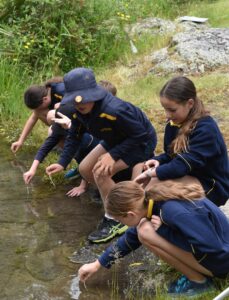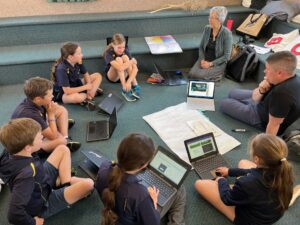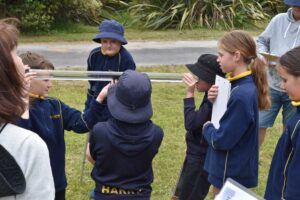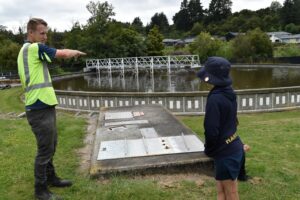Recently I reflected on my first year in Taupō, establishing my Enviroschools Facilitator role with schools in the district, working with and supporting the mahi of Taupō Environmental Education Collaborative. I considered the many wonderful restoration and planting projects in full swing in Taupō (thanks to the efforts of Greening Taupō and Kids Greening Taupō). Many Taupō schools participate in planting, weeding, watering and mulching the project sites. Living Landscapes Theme Area resources complement that mahi well. This led me to think about how the Enviroschools Water of Life Theme Area is clearly associated with many of the projects, and I considered how I could promote this in schools more.
As I continued to mull over the potential for engagement, a few factors came together when a chance meeting with Tina, a SENCO Kairuruku Tautoko Akoranga – Learning Support Coordinator, occurred. Tina was looking for a challenge for some gifted learners she was working with. This matched the goals identified in the Waikato Enviroschools strategy to encourage youth-to-youth voice and linked with the goals of diversity and equity in common with SENCO.
Current Situation
At Wairakei Primary School there was a group of 8 students ready to take on a challenge and lead change in the community. I met with them and took them on a “Drain Detectives” activity to awaken their curiosity about stormwater, wastewater and water sources in Taupō. They expressed disappointment when they discovered what was blown or dropped into drains. Thank you, Hawkes Bay Regional Council for the Drain Detectives guide, available here.

Checking out the water on the edge of the Waikato River.
As the students built an understanding of the situation, they realised how important it is to keep litter out of waterways and considered that perhaps they needed to help their peers and others to understand more about the problem. They surveyed their peers at school to see what they thought about rubbish in the waterways. The survey revealed that all students cared about the effects of litter in waterways but had not realised that they are part of the solution. What could the team change if they could?
Exploring Alternatives
The team’s mahi, by now known as “The Hero Project”, was ready for next steps- to explore alternatives. They asked themselves, “What are our priorities for change?” Based on their current skills and interests they considered how to create a Canva slideshow to upload on YouTube, aimed at educating their fellow students, and ultimately the community would become the focus. It would be about why they should look after our waterways by keeping litter and contaminants out! The students confidently began to design and upload material, with each member of the team contributing. Inspired by another strategic goal to develop storytelling skills and ways to use them I invited Craig Render, Digital Storytelling Aotearoa, to mentor us. He helped us decide what tools would be effective and how to use them.

Facilitator Jenni works with students to raise awareness and plan using the action learning cycle.
In order to be clear about the role each student had in making their YouTube vision a reality and to promote awareness in their school community, the students made good use of a scrum board. It was then clear who was doing what and who needed to complete their job in order for the next steps to happen. Collaboration was becoming more efficient. We used the Enviroschools Design and Action planners as well to be sure of our direction and Vision.
Shannon from Taupō District Council came along to one of the team’s meetings to support them with facts and ideas to positively influence their peers and community.
Taking Action
 Taking action was proving to be the most fun! The completed Canva video is yet to be released on YouTube. The students shared some reasons to reduce waste (and even save money in the process!), be responsible with food packaging, and take care of our environment. Their catchy jingle is fun and has a good message.
Taking action was proving to be the most fun! The completed Canva video is yet to be released on YouTube. The students shared some reasons to reduce waste (and even save money in the process!), be responsible with food packaging, and take care of our environment. Their catchy jingle is fun and has a good message.
Two students composed music for their presentation using Garageband. Others researched the savings and reduction of litter when you choose your food packaging wisely and created a table about this.
Keen to take more immediate action, two members of the team negotiated with their school principal and initiated Nude Food Wednesdays. Duty teachers hand out house tokens to those who manage to bring nude food lunches on Wednesdays. It’s just a start!
Due to one of our stars becoming temporarily incapacitated (badly breaking his leg) at the start of the term, more of our “Identifying the Current Situation” part (of the Enviroschools Action Learning Cycle) happened toward the end of the term. To deepen the students’ understanding about urban water processes, the team went to the water intake treatment plant beside Lake Taupō to see where the water supply is taken from the lake and treated to ensure high quality drinking water.

Measuring the clarity of the water.

Hearing about, seeing and smelling the wastewater treatment system.

Trapped wipes and debris that should not go down a toilet.
Next, they visited one of the wastewater treatment plants, where they observed the plant in action, and learned that many things are flushed down toilets that should not be! The science behind wastewater treatment, the product of which is used in Taupō to pump to farms for irrigation, is fascinating.
We also went to a safe spot by the Waikato River, not far from where it leaves Lake Taupō, to try out some water testing equipment. 100% water clarity! What’s it like in other places on its journey to the sea? We could find out here.
Reflecting on change
From identifying a situation at the end of term 3, exploring options and taking action in Term 4, the team ended the year reflecting on their success and their learning. Thumbs up all round. There was a unanimous response to “What would we change if we could?” regarding the experience: Start earlier in the year! Point taken.
There will be a follow-on from this project, as these students move to their next school. Some Wairakei Primary School students are waiting in the wings to ensure the work of the Hero Project continues. We hope to extend the group to include other schools, and to reach out to the wider community. Read more about the project here: Wairakei Primary School Blog Enviroschools
We may also contact other schools along the mighty Waikato who test the Waikato River and coordinate testing and recording and sharing our data.
Taupō schools are keen to continue the mahi with the Hero Project. As a result of this interest, there is a Water of Life interactive EXPO hosted by the National Trout Centre, Tūrangi being planned. It is attracting a lot of interest from keen presenters from organisations such as Taupō Environmental Education Collaborative, NIWA, Contact Energy, Mercury Energy, MPI, Taupō District Council, Department of Conservation, and Waikato Regional Council, the Taupō Harbourmaster (who is tangata whenua) … the list is not yet complete! Up to 240 students will experience interactive ways to gain information and understanding that will deepen their appreciation of the place water plays in their lives.